Prediction of Soil Organic Carbon under Different Land Use Types Using Sentinel-1/-2 Data in a Small Watershed
Abstract
1. Introduction
2. Materials and Methods
2.1. Study Area
2.2. Sample Collection and Preparation
2.3. Data Acquisition and Processing
2.3.1. Sentinel-1 Images
2.3.2. Sentinel-2 Images
2.3.3. DEM and Land Use
2.4. Statistical Analysis
2.5. XGboost Algorithm
2.6. Assessing Model Performance
3. Results
3.1. Statistical Analysis of SOC
3.2. Analysis of SOC Prediction Results
3.2.1. Feature Selection and Model Evaluation
3.2.2. Importance of Predictor Variables
4. Discussion
4.1. Performance of Prediction Models under Orchard, Dry Land, and Paddy Field
4.2. Variable Importance
5. Conclusions
Author Contributions
Funding
Institutional Review Board Statement
Informed Consent Statement
Data Availability Statement
Acknowledgments
Conflicts of Interest
Appendix A
| Type | Index | Formulation | References |
|---|---|---|---|
| Soil radiometric indices | Brightness Index (BI) | sqrt ((B42 + B32)/2) | [74] |
| Second Brightness Index (BI2) | sqrt ((B42 + B32 + B82)/3) | [74] | |
| Redness Index (RI) | B42/B33 | [75] | |
| Color Index (CI) | (B4 − B3)/(B4 + B3) | [75] | |
| Vegetation radiometric indices | Soil Adjusted Vegetation Index (SAVI) | (1 + L) × (B8 − B4)/(B8 + B4 + L) | [76] |
| Transformed Soil Adjusted Vegetation Index (TSAVI) | s × (B8 − s × B4 − a)/(s × B8 + B4 − a × s + X × (1 + s2)) | [77] | |
| Modified Soil Adjusted Vegetation Index (MSAVI) | (1 + M) × (B8 − B4)/(B8 + B4 + L) | [78] | |
| Second Modified Soil Adjusted Vegetation Index (MSAVI2) | (1/2) × (2 × B8 + 1 − sqrt ((2 × B8 + 1)2 − 8 × (B8 − B4))) | [79] | |
| Difference Vegetation Index (DVI) | B8 − B4 | [80] | |
| Ratio Vegetation Index (RVI) | B8/B4 | [81] | |
| Perpendicular Vegetation Index (PVI) | sin(b) × B8 − cos(b) × B4 | [82] | |
| Infrared Percentage Vegetation Index (IPVI) | B8/(B8 + B4) | [83] | |
| Weighted Difference Vegetation Index (WDVI) | (B8 − s × B4) | [84] | |
| Transformed Normalized Difference Vegetation Index (TNDVI) | Sqrt ((B8 − B4)/(B8 + B4) + 0.5) | [85] | |
| Green Normalized Difference Vegetation Index (GNDVI) | (B7 − B3)/(B7 + B3) | [86] | |
| Global Environmental Monitoring Index (GEMI) | eta × (1 − 0.25 × eta) − (B4 − 0.125)/(1 − B4) | [87] | |
| Atmospherically Resistant Vegetation Index (ARVI) | (B8 − rb)/(B8 + rb) | [88] | |
| Normalized Difference Index (NDI45) | (B5 − B4)/(B5 + B4) | [89] | |
| Meris Terrestrial Chlorophyll Index (MTCI) | (B6 − B5)/(B5 − B4) | [90] | |
| Modified Chlorophyll Absorption Ratio Index (MCARI) | [(B5 − B4) − 0.2 × (B5 − B3)] × (B5/B4) | [91] | |
| Red-Edge Inflection Point Index (REIP) | 705 + 35 × ((B4 + B7)/2 − B5)/(B6 − B5) | [92] | |
| Inverted Red-Edge Chlorophyll Index (IRECI) | (B7 − B4)/(B5/B6) | [93] | |
| Pigment Specific Simple Ratio algorithm (PSSRa) | B7/B4 | [94] | |
| Normalized Difference Vegetation Index (NDVI) | (B8 − B4)/(B8+ B4) | [95] |
| DEM | Sentinel-1 | Sentinel-2 | |
|---|---|---|---|
| Total area | 0.22 | 0.12 | 0.29 |
| orchard | 0.05 | 0.11 | 0.46 |
| dry land | 0.14 | 0.31 | 0.36 |
| paddy field | 0.10 | 0.04 | 0.46 |
| Land Use Type | Model | Eta | Max_Depth | Min_Child_Weight | Lambda | Num_Round |
|---|---|---|---|---|---|---|
| Total area | Model A | 0.05 | 3 | 2 | 1 | 64 |
| Model B | 0.05 | 3 | 3 | 1 | 70 | |
| Model C | 0.05 | 4 | 13 | 1 | 72 | |
| Model D | 0.05 | 4 | 13 | 1 | 72 | |
| Orchard | Model A | 0.05 | 7 | 1 | 1 | 999 |
| Model B | 0.05 | 1 | 2 | 1 | 894 | |
| Model C | 0.05 | 8 | 1 | 1 | 118 | |
| Model D | 0.05 | 8 | 1 | 1 | 118 | |
| Dry land | Model A | 0.05 | 2 | 3 | 1 | 54 |
| Model B | 0.05 | 3 | 5 | 1 | 70 | |
| Model C | 0.05 | 2 | 3 | 1 | 128 | |
| Model D | 0.05 | 2 | 3 | 1 | 128 | |
| Paddy field | Model A | 0.1 | 1 | 16 | 14 | 40 |
| Model B | 0.05 | 7 | 3 | 1 | 50 | |
| Model C | 0.1 | 6 | 1 | 1 | 41 | |
| Model D | 0.1 | 6 | 1 | 1 | 41 |
| Calibration | Validation | |||||||||
|---|---|---|---|---|---|---|---|---|---|---|
| Land Use Type | Min | Max | Mean | SD | CV | Min | Max | Mean | SD | CV |
| Total area | 0.15 | 1.66 | 0.82 | 0.23 | 0.29 | 0.42 | 1.58 | 0.79 | 0.22 | 0.28 |
| Orchard | 0.40 | 1.32 | 0.75 | 0.19 | 0.26 | 0.55 | 1.28 | 0.80 | 0.18 | 0.22 |
| Dry land | 0.15 | 1.26 | 0.70 | 0.23 | 0.33 | 0.43 | 1.01 | 0.67 | 0.18 | 0.27 |
| Paddy field | 0.42 | 1.66 | 0.89 | 0.24 | 0.27 | 0.59 | 1.29 | 0.88 | 0.16 | 0.18 |
| Type | Feature | Orchard | Dry Land | Paddy Field |
|---|---|---|---|---|
| Sentinel-1 | VH_1 | −0.11 | −0.14 | −0.01 |
| VV_1 | 0.01 | −0.12 | 0.06 | |
| VH_2 | −0.08 | 0.03 | −0.10 | |
| VV_2 | −0.11 | −0.13 | 0.06 | |
| VH_3 | −0.07 | −0.06 | −0.22 ** | |
| VV_3 | −0.10 | −0.05 | −0.18 * | |
| VH_4 | −0.16 | −0.21 | −0.11 | |
| VV_4 | −0.22 | −0.12 | −0.19 * | |
| VH_5 | −0.13 | 0.07 | −0.12 | |
| VV_5 | −0.14 | 0.03 | −0.12 | |
| VH_6 | −0.09 | −0.07 | 0.08 | |
| VV_6 | 0.00 | −0.12 | 0.08 | |
| Sentinel-2 | B2 | 0.26 * | 0.09 | −0.13 |
| B3 | 0.28 * | 0.05 | −0.15 | |
| B4 | 0.20 | 0.11 | −0.12 | |
| B5 | 0.26 * | 0.06 | −0.16 * | |
| B6 | 0.13 | −0.33 ** | −0.22 ** | |
| B7 | 0.11 | −0.33 ** | −0.09 | |
| B8 | 0.16 | −0.35 ** | −0.09 | |
| B8A | 0.11 | −0.34 ** | −0.09 | |
| B11 | 0.23 * | −0.10 | −0.33 ** | |
| B12 | 0.26 * | −0.01 | −0.24 ** | |
| BI | 0.25 * | 0.08 | −0.14 | |
| BI2 | 0.21 | −0.33 ** | −0.11 | |
| CI | 0.07 | 0.18 | −0.10 | |
| RI | −0.03 | 0.16 | −0.03 | |
| ARVI | −0.10 | −0.22 | 0.11 | |
| DVI | 0.06 | −0.35 ** | −0.02 | |
| GEMI | 0.00 | −0.34 ** | −0.01 | |
| GNDVI | −0.14 | −0.24 | 0.10 | |
| IPVI | −0.12 | −0.23 | 0.10 | |
| IRECI | −0.02 | −0.34 ** | −0.03 | |
| MCARI | 0.04 | −0.09 | 0.00 | |
| MSAVI | 0.02 | −0.34 ** | 0.01 | |
| MSAVI2 | 0.01 | −0.34 ** | 0.02 | |
| MTCI | −0.02 | −0.03 | −0.10 | |
| NDI45 | −0.09 | −0.13 | 0.09 | |
| NDVI | −0.12 | −0.23 | 0.10 | |
| PSSRA | −0.06 | −0.26 * | 0.10 | |
| PVI | 0.06 | −0.35 ** | −0.02 | |
| REIP | 0.00 | −0.14 | 0.25 ** | |
| RVI | −0.03 | −0.26 * | 0.08 | |
| SAVI | −0.01 | −0.33 ** | 0.02 | |
| TNDVI | −0.12 | −0.22 | 0.09 | |
| TSAVI | 0.17 | −0.31 ** | −0.14 | |
| WDVI | 0.02 | −0.34 ** | 0.00 | |
| DEM | Elevation | 0.01 | 0.19 | 0.21 * |
| Slope | −0.31 ** | −0.15 | −0.18 * | |
| Aspect | −0.04 | 0.05 | 0.06 |
References
- Raich, J.W.; Potter, C.S.; Bhagawati, D. Interannual variability in global soil respiration, 1980–1994. Glob. Chang. Biol. 2002, 8, 800–812. [Google Scholar] [CrossRef]
- Karhu, K.; Auffret, M.D.; Dungait, J.A.; Hopkins, D.W.; Prosser, J.I.; Singh, B.K.; Subke, J.A.; Wookey, P.A.; Agren, G.I.; Sebastia, M.T.; et al. Temperature sensitivity of soil respiration rates enhanced by microbial community response. Nature 2014, 513, 81–84. [Google Scholar] [CrossRef]
- McBratney, A.B.; Stockmann, U.; Angers, D.A.; Minasny, B.; Field, D.J. Challenges for Soil Organic Carbon Research. In Soil Carbon; Hartemink, A.E., McSweeney, K., Eds.; Springer: Cham, Switzerland, 2014; pp. 3–16. [Google Scholar]
- Zhang, G.; Zheng, C.Y.; Wang, Y.; Li, Y.F.; Xin, Y. Soil organic carbon and microbial community structure exhibit different responses to three land use types in the North China Plain. Agric. Scand. Sect. B Soil Plant Sci. 2015, 65, 341–349. [Google Scholar] [CrossRef]
- Wang, S.Q.; Liu, J.Y.; Yu, G.R.; Pan, Y.Y.; Chen, Q.M.; Li, K.R.; Li, J.Y. Effects of land use change on the storage of soil organic carbon: A case study of the Qianyanzhou Forest Experimental Station in China. Clim. Chang. 2004, 67, 247–255. [Google Scholar]
- Aldana-Jague, E.; Heckrath, G.; Macdonald, A.; Van Wesemael, B.; Van Oost, K. UAS-based soil carbon mapping using VIS-NIR (480–1000 nm) multi-spectral imaging: Potential and limitations. Geoderma 2016, 275, 55–66. [Google Scholar] [CrossRef]
- Baldock, J.A.; Hawke, B.; Sanderman, J.; Macdonald, L.M. Predicting contents of carbon and its component fractions in Australian soils from diffuse reflectance mid-infrared spectra. Soil Res. 2013, 51, 577–583. [Google Scholar] [CrossRef]
- Lu, P.; Wang, L.; Niu, Z.; Li, L.; Zhang, W. Prediction of soil properties using laboratory VIS–NIR spectroscopy and Hyperion imagery. J. Geochem. Explor. 2013, 132, 26–33. [Google Scholar] [CrossRef]
- Liu, J.B.; Han, J.C.; Zhang, Y.; Wang, H.Y.; Kong, H.; Shi, L. Prediction of soil organic carbon with different parent materials development using visible-near infrared spectroscopy. Spectroc. Acta Pt. A Molec. Biomolec. Spectr. 2018, 204, 33–39. [Google Scholar] [CrossRef] [PubMed]
- Stevens, A.; Nocita, M.; Toth, G.; Montanarella, L.; van Wesemael, B. Prediction of Soil Organic Carbon at the European Scale by Visible and Near InfraRed Reflectance Spectroscopy. PLoS ONE 2013, 8, e66409. [Google Scholar] [CrossRef] [PubMed]
- Liu, L.F.; Ji, M.; Dong, Y.Y.; Zhang, R.C.; Buchroithner, M. Quantitative Retrieval of Organic Soil Properties from Visible Near-Infrared Shortwave Infrared (Vis-NIR-SWIR) Spectroscopy Using Fractal-Based Feature Extraction. Remote Sens. 2016, 8, 1035. [Google Scholar] [CrossRef]
- Zhang, Y.K.; Hartemink, A.E. Data fusion of vis-NIR and PXRF spectra to predict soil physical and chemical properties. Eur. J. Soil Sci. 2020, 71, 316–333. [Google Scholar] [CrossRef]
- Rossel, R.A.V.; Walvoort, D.J.J.; McBratney, A.B.; Janik, L.J.; Skjemstad, J.O. Visible, near infrared, mid infrared or combined diffuse reflectance spectroscopy for simultaneous assessment of various soil properties. Geoderma 2006, 131, 59–75. [Google Scholar] [CrossRef]
- Peng, Y.; Xiong, X.; Adhikari, K.; Knadel, M.; Grunwald, S.; Greve, M.H. Modeling Soil Organic Carbon at Regional Scale by Combining Multi-Spectral Images with Laboratory Spectra. PLoS ONE 2015, 10, e0142295. [Google Scholar] [CrossRef]
- Castaldi, A.; Chabrillat, S.; Don, A.; van Wesemael, B. Soil Organic Carbon Mapping Using LUCAS Topsoil Database and Sentinel-2 Data: An Approach to Reduce Soil Moisture and Crop Residue Effects. Remote Sens. 2019, 11, 2121. [Google Scholar] [CrossRef]
- Vaudour, E.; Gomez, C.; Fouad, Y.; Lagacherie, P. Sentinel-2 image capacities to predict common topsoil properties of temperate and Mediterranean agroecosystems. Remote Sens. Environ. 2019, 223, 21–33. [Google Scholar] [CrossRef]
- Taghizadeh-Mehrjardi, R.; Schmidt, K.; Amirian-Chakan, A.; Rentschler, T.; Zeraatpisheh, M.; Sarmadian, F.; Valavi, R.; Davatgar, N.; Behrens, T.; Scholten, T. Improving the Spatial Prediction of Soil Organic Carbon Content in Two Contrasting Climatic Regions by Stacking Machine Learning Models and Rescanning Covariate Space. Remote Sens. 2020, 12, 1095. [Google Scholar] [CrossRef]
- Castaldi, F.; Hueni, A.; Chabrillat, S.; Ward, K.; Buttafuoco, G.; Bomans, B.; Vreys, K.; Brell, M.; van Wesemael, B. Evaluating the capability of the Sentinel 2 data for soil organic carbon prediction in croplands. ISPRS J. Photogramm. Remote Sens. 2019, 147, 267–282. [Google Scholar] [CrossRef]
- Gholizadeh, A.; Zizala, D.; Saberioon, M.; Boruvka, L. Soil organic carbon and texture retrieving and mapping using proximal, airborne and Sentinel-2 spectral imaging. Remote Sens. Environ. 2018, 218, 89–103. [Google Scholar] [CrossRef]
- Zhou, T.; Geng, Y.; Ji, C.; Xu, X.; Wang, H.; Pan, J.; Bumberger, J.; Haase, D.; Lausch, A. Prediction of soil organic carbon and the C:N ratio on a national scale using machine learning and satellite data: A comparison between Sentinel-2, Sentinel-3 and Landsat-8 images. Sci. Total Environ. 2021, 755, 142661. [Google Scholar] [CrossRef]
- Vaudour, E.; Gomez, C.; Lagacherie, P.; Loiseau, T.; Baghdadi, N.; Urbina-Salazar, D.; Loubet, B.; Arrouays, D. Temporal mosaicking approaches of Sentinel-2 images for extending topsoil organic carbon content mapping in croplands. Int. J. Appl. Earth Obs. Geoinf. 2021, 96, 102277. [Google Scholar] [CrossRef]
- Ramcharan, A.; Hengl, T.; Nauman, T.; Brungard, C.; Waltman, S.; Wills, S.; Thompson, J. Soil Property and Class Maps of the Conterminous United States at 100-Meter Spatial Resolution. Soil Sci. Soc. Am. J. 2018, 82, 186–201. [Google Scholar] [CrossRef]
- Mahmoudzadeh, H.; Matinfar, H.R.; Taghizadeh-Mehrjardi, R.; Kerry, R. Spatial prediction of soil organic carbon using machine learning techniques in western Iran. Geoderma Reg. 2020, 21, e00260. [Google Scholar] [CrossRef]
- Emadi, M.; Taghizadeh-Mehrjardi, R.; Cherati, A.; Danesh, M.; Mosavi, A.; Scholten, T. Predicting and Mapping of Soil Organic Carbon Using Machine Learning Algorithms in Northern Iran. Remote Sens. 2020, 12, 2234. [Google Scholar] [CrossRef]
- Zeraatpisheh, M.; Ayoubi, S.; Jafari, A.; Tajik, S.; Finke, P. Digital mapping of soil properties using multiple machine learning in a semi-arid region, central Iran. Geoderma 2019, 338, 445–452. [Google Scholar] [CrossRef]
- Safanelli, J.L.; Chabrillat, S.; Ben-Dor, E.; Dematte, J.A.M. Multispectral Models from Bare Soil Composites for Mapping Topsoil Properties over Europe. Remote Sens. 2020, 12, 1369. [Google Scholar] [CrossRef]
- Li, X.; Shang, B.; Wang, D.; Wang, Z.; Wen, X.; Kang, Y. Mapping soil organic carbon and total nitrogen in croplands of the Corn Belt of Northeast China based on geographically weighted regression kriging model. Comput. Geosci. 2020, 135, 104392. [Google Scholar] [CrossRef]
- Zhang, Y.; Shen, H.; Gao, Q.; Zhao, L. Estimating soil organic carbon and pH in Jilin Province using Landsat and ancillary data. Soil Sci. Soc. Am. J. 2020, 84, 556–567. [Google Scholar] [CrossRef]
- Hengl, T.; Leenaars, J.G.B.; Shepherd, K.D.; Walsh, M.G.; Heuvelink, G.B.M.; Mamo, T.; Tilahun, H.; Berkhout, E.; Cooper, M.; Fegraus, E.; et al. Soil nutrient maps of Sub-Saharan Africa: Assessment of soil nutrient content at 250 m spatial resolution using machine learning. Nutr. Cycl. Agroecosyst. 2017, 109, 77–102. [Google Scholar] [CrossRef]
- Hengl, T.; Mendes de Jesus, J.; Heuvelink, G.B.; Ruiperez Gonzalez, M.; Kilibarda, M.; Blagotic, A.; Shangguan, W.; Wright, M.N.; Geng, X.; Bauer-Marschallinger, B.; et al. SoilGrids250m: Global gridded soil information based on machine learning. PLoS ONE 2017, 12, e0169748. [Google Scholar] [CrossRef] [PubMed]
- Liang, Z.; Chen, S.; Yang, Y.; Zhou, Y.; Shi, Z. High-resolution three-dimensional mapping of soil organic carbon in China: Effects of SoilGrids products on national modeling. Sci. Total Environ. 2019, 685, 480–489. [Google Scholar] [CrossRef] [PubMed]
- Cai, H.K.; Feng, X.; Chen, Q.L.; Sun, Y.; Wu, Z.M.; Tie, X. Spatial and Temporal Features of the Frequency of Cloud Occurrence over China Based on CALIOP. Adv. Meteorol. 2017, 2017. [Google Scholar] [CrossRef]
- Zhou, T.; Geng, Y.; Chen, J.; Pan, J.; Haase, D.; Lausch, A. High-resolution digital mapping of soil organic carbon and soil total nitrogen using DEM derivatives, Sentinel-1 and Sentinel-2 data based on machine learning algorithms. Sci. Total Environ. 2020, 729, 138244. [Google Scholar] [CrossRef] [PubMed]
- Poggio, L.; Gimona, A. Assimilation of optical and radar remote sensing data in 3D mapping of soil properties over large areas. Sci. Total Environ. 2017, 579, 1094–1110. [Google Scholar] [CrossRef]
- Wang, X.; Zhang, Y.; Atkinson, P.M.; Yao, H. Predicting soil organic carbon content in Spain by combining Landsat TM and ALOS PALSAR images. Int. J. Appl. Earth Obs. Geoinf. 2020, 92, 102182. [Google Scholar] [CrossRef]
- Zhou, T.; Geng, Y.; Chen, J.; Liu, M.; Haase, D.; Lausch, A. Mapping soil organic carbon content using multi-source remote sensing variables in the Heihe River Basin in China. Ecol. Indic. 2020, 114, 106288. [Google Scholar] [CrossRef]
- Yang, R.M.; Guo, W.W. Modelling of soil organic carbon and bulk density in invaded coastal wetlands using Sentinel-1 imagery. Int. J. Appl. Earth Obs. Geoinf. 2019, 82, 101906. [Google Scholar] [CrossRef]
- Yang, R.-M.; Guo, W.-W. Using time-series Sentinel-1 data for soil prediction on invaded coastal wetlands. Environ. Monit. Assess. 2019, 191, 462. [Google Scholar] [CrossRef] [PubMed]
- Ma, Y.; Minasny, B.; Wu, C. Mapping key soil properties to support agricultural production in Eastern China. Geoderma Reg. 2017, 10, 144–153. [Google Scholar] [CrossRef]
- Zhang, G.L. Changes of Soil Labile Organic Carbon in Different Land Uses in Sanjiang Plain, Heilongjiang Province. Chin. Geogr. Sci. 2010, 20, 139–143. [Google Scholar] [CrossRef]
- Fang, X.; Xue, Z.J.; Li, B.C.; An, S.S. Soil organic carbon distribution in relation to land use and its storage in a small watershed of the Loess Plateau, China. Catena 2012, 88, 6–13. [Google Scholar] [CrossRef]
- Emadi, M.; Baghernejad, M.; Memarian, H.R. Effect of land-use change on soil fertility characteristics within water-stable aggregates of two cultivated soils in northern Iran. Land Use Pol. 2009, 26, 452–457. [Google Scholar] [CrossRef]
- Zhang, H.; Wu, P.; Yin, A.; Yang, X.; Zhang, M.; Gao, C. Prediction of soil organic carbon in an intensively managed reclamation zone of eastern China: A comparison of multiple linear regressions and the random forest model. Sci. Total Environ. 2017, 592, 704–713. [Google Scholar] [CrossRef]
- Paul, S.S.; Coops, N.C.; Johnson, M.S.; Krzic, M.; Chandna, A.; Smukler, S.M. Mapping soil organic carbon and clay using remote sensing to predict soil workability for enhanced climate change adaptation. Geoderma 2020, 363, 114177. [Google Scholar] [CrossRef]
- Biney, J.K.M.; Saberioon, M.; Boruvka, L.; Houska, J.; Vasat, R.; Agyeman, P.C.; Coblinski, J.A.; Klement, A. Exploring the Suitability of UAS-Based Multispectral Images for Estimating Soil Organic Carbon: Comparison with Proximal Soil Sensing and Spaceborne Imagery. Remote Sens. 2021, 13, 308. [Google Scholar] [CrossRef]
- Lin, C.; Tu, S.; Huang, J.; Chen, Y. The effect of plant hedgerows on the spatial distribution of soil erosion and soil fertility on sloping farmland in the purple-soil area of China. Soil Tillage Res. 2009, 105, 307–312. [Google Scholar] [CrossRef]
- Wang, H.J.; Shi, X.Z.; Yu, D.S.; Weindorf, D.C.; Huang, B.; Sun, W.X.; Ritsema, C.J.; Milne, E. Factors determining soil nutrient distribution in a small-scaled watershed in the purple soil region of Sichuan Province, China. Soil Tillage Res. 2009, 105, 300–306. [Google Scholar] [CrossRef]
- Li, M.; Xi, X.H.; Xiao, G.Y.; Cheng, H.X.; Yang, Z.F.; Zhou, G.H.; Ye, J.Y.; Li, Z.H. National multi-purpose regional geochemical survey in China. J. Geochem. Explor. 2014, 139, 21–30. [Google Scholar] [CrossRef]
- Torres, R.; Snoeij, P.; Geudtner, D.; Bibby, D.; Davidson, M.; Attema, E.; Potin, P.; Rommen, B.; Floury, N.; Brown, M.; et al. GMES Sentinel-1 mission. Remote Sens. Environ. 2012, 120, 9–24. [Google Scholar] [CrossRef]
- Yu, G.M.; Yu, Q.W.; Hu, L.M.; Zhang, S.; Fu, T.T.; Zhou, X.; He, X.L.; Liu, Y.A.; Wang, S.; Jia, H.H. Ecosystem health assessment based on analysis of a land use database. Appl. Geogr. 2013, 44, 154–164. [Google Scholar] [CrossRef]
- Zhou, J.; Li, E.M.; Wang, M.Z.; Chen, X.; Shi, X.Z.; Jiang, L.S. Feasibility of Stochastic Gradient Boosting Approach for Evaluating Seismic Liquefaction Potential Based on SPT and CPT Case Histories. J. Perform. Constr. Facil. 2019, 33. [Google Scholar] [CrossRef]
- Yu, X.; Wang, Y.H.; Wu, L.F.; Chen, G.H.; Wang, L.; Qin, H. Comparison of support vector regression and extreme gradient boosting for decomposition-based data-driven 10-day streamflow forecasting. J. Hydrol. 2020, 582, 124293. [Google Scholar] [CrossRef]
- Zheng, H.T.; Yuan, J.B.; Chen, L. Short-Term Load Forecasting Using EMD-LSTM Neural Networks with a Xgboost Algorithm for Feature Importance Evaluation. Energies 2017, 10, 1168. [Google Scholar] [CrossRef]
- Jia, Y.; Jin, S.G.; Savi, P.; Gao, Y.; Tang, J.; Chen, Y.X.; Li, W.M. GNSS-R Soil Moisture Retrieval Based on a XGboost Machine Learning Aided Method: Performance and Validation. Remote Sens. 2019, 11, 1655. [Google Scholar] [CrossRef]
- Wei, L.; Yuan, Z.; Wang, Z.; Zhao, L.; Zhang, Y.; Lu, X.; Cao, L. Hyperspectral Inversion of Soil Organic Matter Content Based on a Combined Spectral Index Model. Sensors 2020, 20, 2777. [Google Scholar] [CrossRef]
- Li, M.F.; Tang, X.P.; Wu, W.; Liu, H.B. General models for estimating daily global solar radiation for different solar radiation zones in mainland China. Energy Convers. Manag. 2013, 70, 139–148. [Google Scholar] [CrossRef]
- Hua, S.; Qinghua, S.; Xiaomin, Z.; Xi, G.; Zhihong, L. Impacts of Various Agricultural Land Use Patterns on the Content of Organic Carbon in Soil in Jiangxi Province. China Land Sci. 2010, 24, 13–17. [Google Scholar]
- Liu, S.L.; Dong, Y.H.; Cheng, F.Y.; Yin, Y.J.; Zhang, Y.Q. Variation of soil organic carbon and land use in a dry valley in Sichuan province, Southwestern China. Ecol. Eng. 2016, 95, 501–504. [Google Scholar] [CrossRef]
- Liu, S.L.; Fu, B.J.; Lu, Y.H.; Chen, L.D. Effects of reforestation and deforestation on soil properties in humid mountainous areas: A case study in Wolong Nature Reserve, Sichuan province, China. Soil Use Manag. 2002, 18, 376–380. [Google Scholar] [CrossRef]
- Zhao, W.; Zhang, R.; Cao, H.; Tan, W.F. Factor contribution to soil organic and inorganic carbon accumulation in the Loess Plateau: Structural equation modeling. Geoderma 2019, 352, 116–125. [Google Scholar] [CrossRef]
- Zhang, Z.Q.; Yu, D.S.; Shi, X.Z.; Warner, E.; Ren, H.Y.; Sun, W.X.; Tan, M.Z.; Wang, H.J. Application of categorical information in the spatial prediction of soil organic carbon in the red soil area of China. Soil Sci. Plant Nutr. 2010, 56, 307–318. [Google Scholar] [CrossRef]
- Stenberg, B.; Viscarra Rossel, R.A.; Mouazen, A.M.; Wetterlind, J. Chapter Five—Visible and Near Infrared Spectroscopy in Soil Science. In Advances in Agronomy; Sparks, D.L., Ed.; Academic Press: Burlington, VT, USA, 2010; pp. 163–215. [Google Scholar]
- Li, Q.-Q.; Yue, T.X.; Wang, C.Q.; Zhang, W.J.; Yu, Y.; Li, B.; Yang, J.; Bai, G.C. Spatially distributed modeling of soil organic matter across China: An application of artificial neural network approach. Catena 2013, 104, 210–218. [Google Scholar] [CrossRef]
- Kokulan, V.; Akinremi, O.; Moulin, A.P.; Kumaragamage, D. Importance of terrain attributes in relation to the spatial distribution of soil properties at the micro scale: A case study. Can. J. Soil Sci. 2018, 98, 292–305. [Google Scholar] [CrossRef]
- Ceddia, M.B.; Gomes, A.S.; Vasques, G.M.; Pinheiro, E.F.M. Soil Carbon Stock and Particle Size Fractions in the Central Amazon Predicted from Remotely Sensed Relief, Multispectral and Radar Data. Remote Sens. 2017, 9, 124. [Google Scholar] [CrossRef]
- Mahmoudabadi, E.; Karimi, A.; Haghnia, G.H.; Sepehr, A. Digital soil mapping using remote sensing indices, terrain attributes, and vegetation features in the rangelands of northeastern Iran. Environ. Monit. Assess. 2017, 189, 500. [Google Scholar] [CrossRef] [PubMed]
- Kasischke, E.S.; Melack, J.M.; Dobson, M.C. The use of imaging radars for ecological applications—A review. Remote Sens. Environ. 1997, 59, 141–156. [Google Scholar] [CrossRef]
- Veloso, A.; Mermoz, S.; Bouvet, A.; Toan, T.L.; Planells, M.; Dejoux, J.-F.; Ceschia, E. Understanding the temporal behavior of crops using Sentinel-1 and Sentinel-2-like data for agricultural applications. Remote Sens. Environ. 2017, 199, 415–426. [Google Scholar] [CrossRef]
- Brown, S.C.M.; Quegan, S.; Morrison, K.; Bennett, J.C.; Cookmartin, G. High-resolution measurements of scattering in wheat canopies—Implications for crop parameter retrieval. IEEE Trans. Geosci. Remote Sens. 2003, 41, 1602–1610. [Google Scholar] [CrossRef]
- Pretorius, M.L.; Van Huyssteen, C.W.; Brown, L.R. Soil color indicates carbon and wetlands: Developing a color-proxy for soil organic carbon and wetland boundaries on sandy coastal plains in South Africa. Environ. Monit. Assess. 2017, 189, 18. [Google Scholar] [CrossRef]
- Kumar, N.; Velmurugan, A.; Hamm, N.A.S.; Dadhwal, V.K. Geospatial Mapping of Soil Organic Carbon Using Regression Kriging and Remote Sensing. J. Indian Soc. Remote Sens. 2018, 46, 705–716. [Google Scholar] [CrossRef]
- Dinakaran, J.; Bidalia, A.; Kumar, A.; Hanief, M.; Meena, A.; Rao, K.S. Near-Infrared-Spectroscopy for Determination of Carbon and Nitrogen in Indian Soils. Commun. Soil Sci. Plant Anal. 2016, 47, 1503–1516. [Google Scholar] [CrossRef]
- Gao, Q.; Zribi, M.; Escorihuela, M.J.; Baghdadi, N.; Segui, P.Q. Irrigation Mapping Using Sentinel-1 Time Series at Field Scale. Remote Sens. 2018, 10, 1495. [Google Scholar] [CrossRef]
- Escadafal, R.; Girard, M.C.; Courault, D. Munsell Soil Color and Soil Reflectance in the Visible Spectral Bands of Landsat Mss and Tm Data. Remote Sens. Environ. 1989, 27, 37–46. [Google Scholar] [CrossRef]
- Pouget, M.; Madeira, J.; Le Floch, E.; Kamal, S. Caracteristiques Spectrales des Surfaces Sableuses de La Region Cotiere Nord-Ouest de L’Egypte: Application Aux Donnees Satellitaires SPOT. In Proceedings of the 2eme JoumCes de T&detection: Caracterisation et Suivi des Milieux Terrestres En Regions Arides et Tropicales, Paris, France, 4–6 December 1990; pp. 27–38. [Google Scholar]
- Huete, A.R. A Soil-Adjusted Vegetation Index (Savi). Remote Sens. Environ. 1988, 25, 295–309. [Google Scholar] [CrossRef]
- Baret, F.; Guyot, G. Potentials and Limits of Vegetation Indexes for Lai and Apar Assessment. Remote Sens. Environ. 1991, 35, 161–173. [Google Scholar] [CrossRef]
- Qi, J.; Chehbouni, A.; Huete, A.R.; Kerr, Y.H.; Sorooshian, S. A Modified Soil Adjusted Vegetation Index. Remote Sens. Environ. 1994, 48, 119–126. [Google Scholar] [CrossRef]
- Qi, J.; Kerr, Y.; Chehbouni, A. External Factor Consideration in Vegetation Index Development. In Proceedings of the 6th International Symposium on Physical Measurements and Signatures in Remote Sensing, Val D’Isere, France, 17–22 January 1994; pp. 723–730. [Google Scholar]
- Moreau, L.; Li, Z.Q. A new approach for remote sensing of canopy absorbed photosynthetically active radiation. 2. Proportion of canopy absorption. Remote Sens. Environ. 1996, 55, 192–204. [Google Scholar] [CrossRef]
- Gupta, R.K. Comparative-Study of Avhrr Ratio Vegetation Index and Normalized Difference Vegetation Index in District Level Agricultural Monitoring. Int. J. Remote Sens. 1993, 14, 53–73. [Google Scholar] [CrossRef]
- Richardson, A.J.; Wiegand, C.L. Distinguishing Vegetation from Soil Background Information. Photogramm. Eng. Remote Sens. 1977, 43, 1541–1552. [Google Scholar]
- Crippen, R.E. Calculating the Vegetation Index Faster. Remote Sens. Environ. 1990, 34, 71–73. [Google Scholar] [CrossRef]
- Clevers, J.G.P.W. The Derivation of a Simplified Reflectance Model for the Estimation of Leaf-Area Index. Remote Sens. Environ. 1988, 25, 53–69. [Google Scholar] [CrossRef]
- Zhou, X.N.; Lin, D.D.; Yang, H.M.; Chen, H.G.; Sun, L.P.; Yang, G.J.; Hong, Q.B.; Brown, L.; Malone, J.B. Use of landsat TM satellite surveillance data to measure the impact of the 1998 flood on snail intermediate host dispersal in the lower Yangtze River Basin. Acta Trop. 2002, 82, 199–205. [Google Scholar] [CrossRef]
- Gitelson, A.A.; Kaufman, Y.J.; Merzlyak, M.N. Use of a green channel in remote sensing of global vegetation from EOS-MODIS. Remote. Sens. Environ. 1996, 58, 289–298. [Google Scholar] [CrossRef]
- Leprieur, C.; Kerr, Y.H.; Pichon, J.M. Critical assessment of vegetation indices from AVHRR in a semi-arid environment. Int. J. Remote Sens. 1996, 17, 2549–2563. [Google Scholar] [CrossRef]
- Kaufman, Y.J.; Tanre, D. Atmospherically Resistant Vegetation Index (Arvi) for Eos-Modis. IEEE Trans. Geosci. Remote Sens. 1992, 30, 261–270. [Google Scholar] [CrossRef]
- Valerio, F.; Ferreira, E.; Godinho, S.; Pita, R.; Mira, A.; Fernandes, N.; Santos, S.M. Predicting Microhabitat Suitability for an Endangered Small Mammal Using Sentinel-2 Data. Remote Sens. 2020, 12, 562. [Google Scholar] [CrossRef]
- Dash, J.; Curran, P.J. The MERIS terrestrial chlorophyll index. Int. J. Remote Sens. 2004, 25, 5403–5413. [Google Scholar] [CrossRef]
- Daughtry, C.S.T.; Walthall, C.L.; Kim, M.S.; de Colstoun, E.B.; McMurtrey, J.E. Estimating corn leaf chlorophyll concentration from leaf and canopy reflectance. Remote Sens. Environ. 2000, 74, 229–239. [Google Scholar] [CrossRef]
- Vogelmann, J.E.; Rock, B.N.; Moss, D.M. Red Edge Spectral Measurements from Sugar Maple Leaves. Int. J. Remote Sens. 1993, 14, 1563–1575. [Google Scholar] [CrossRef]
- Frampton, W.J.; Dash, J.; Watmough, G.; Milton, E.J. Evaluating the capabilities of Sentinel-2 for quantitative estimation of biophysical variables in vegetation. ISPRS J. Photogramm. Remote Sens. 2013, 82, 83–92. [Google Scholar] [CrossRef]
- Blackburn, G.A. Quantifying chlorophylls and caroteniods at leaf and canopy scales: An evaluation of some hyperspectral approaches. Remote Sens. Environ. 1998, 66, 273–285. [Google Scholar] [CrossRef]
- Huete, A.; Didan, K.; Miura, T.; Rodriguez, E.P.; Gao, X.; Ferreira, L.G. Overview of the radiometric and biophysical performance of the MODIS vegetation indices. Remote Sens. Environ. 2002, 83, 195–213. [Google Scholar] [CrossRef]


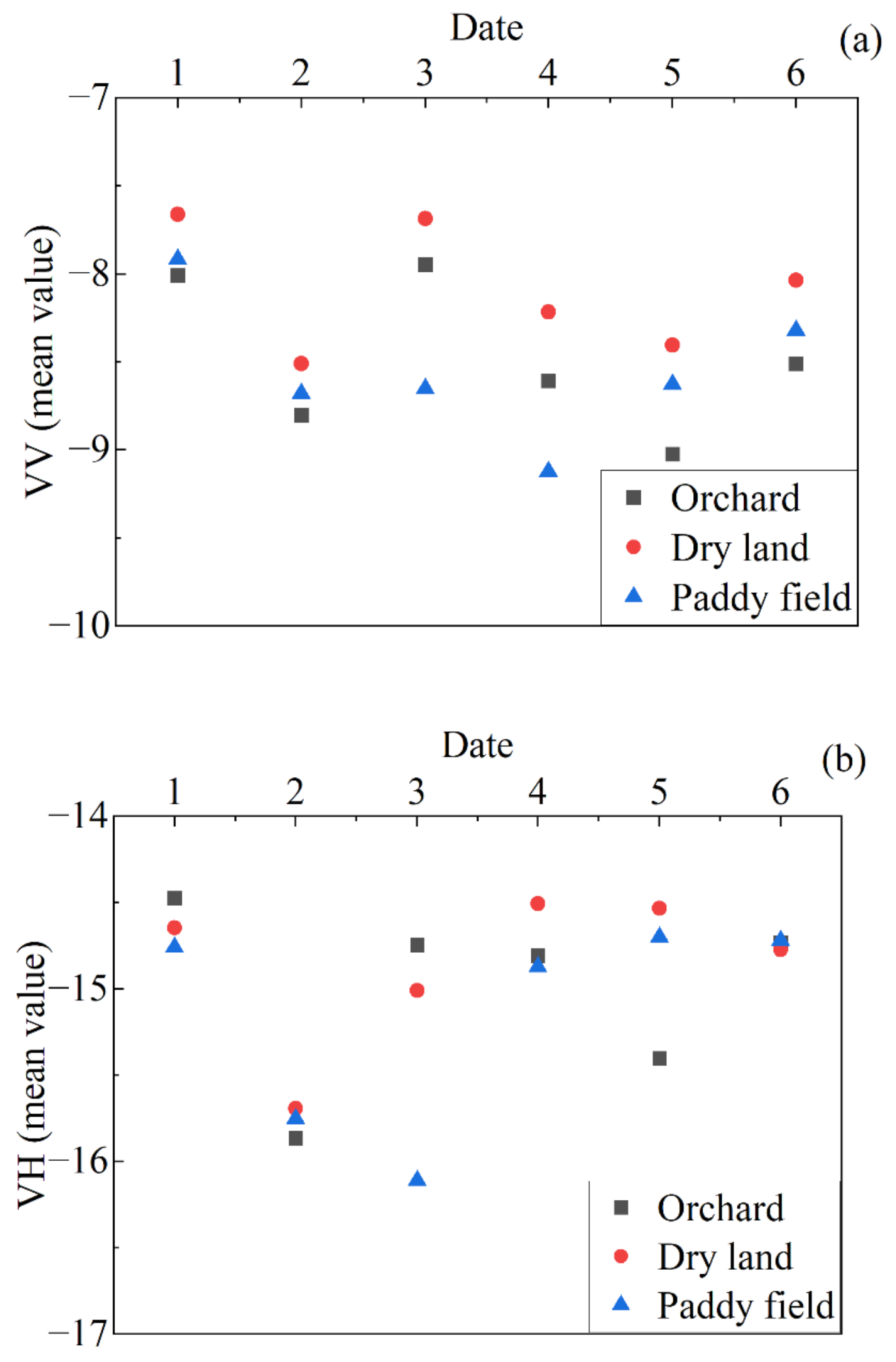
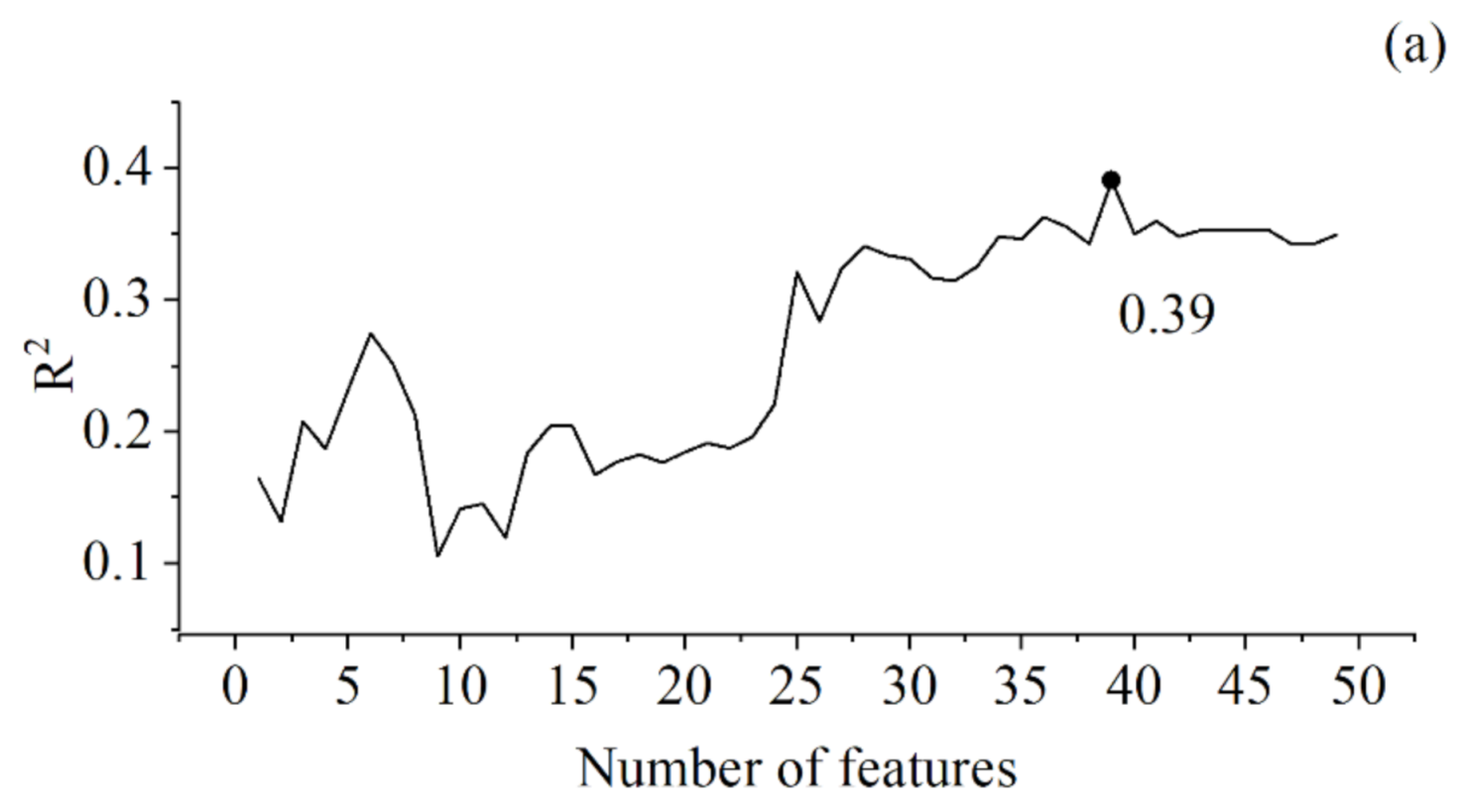

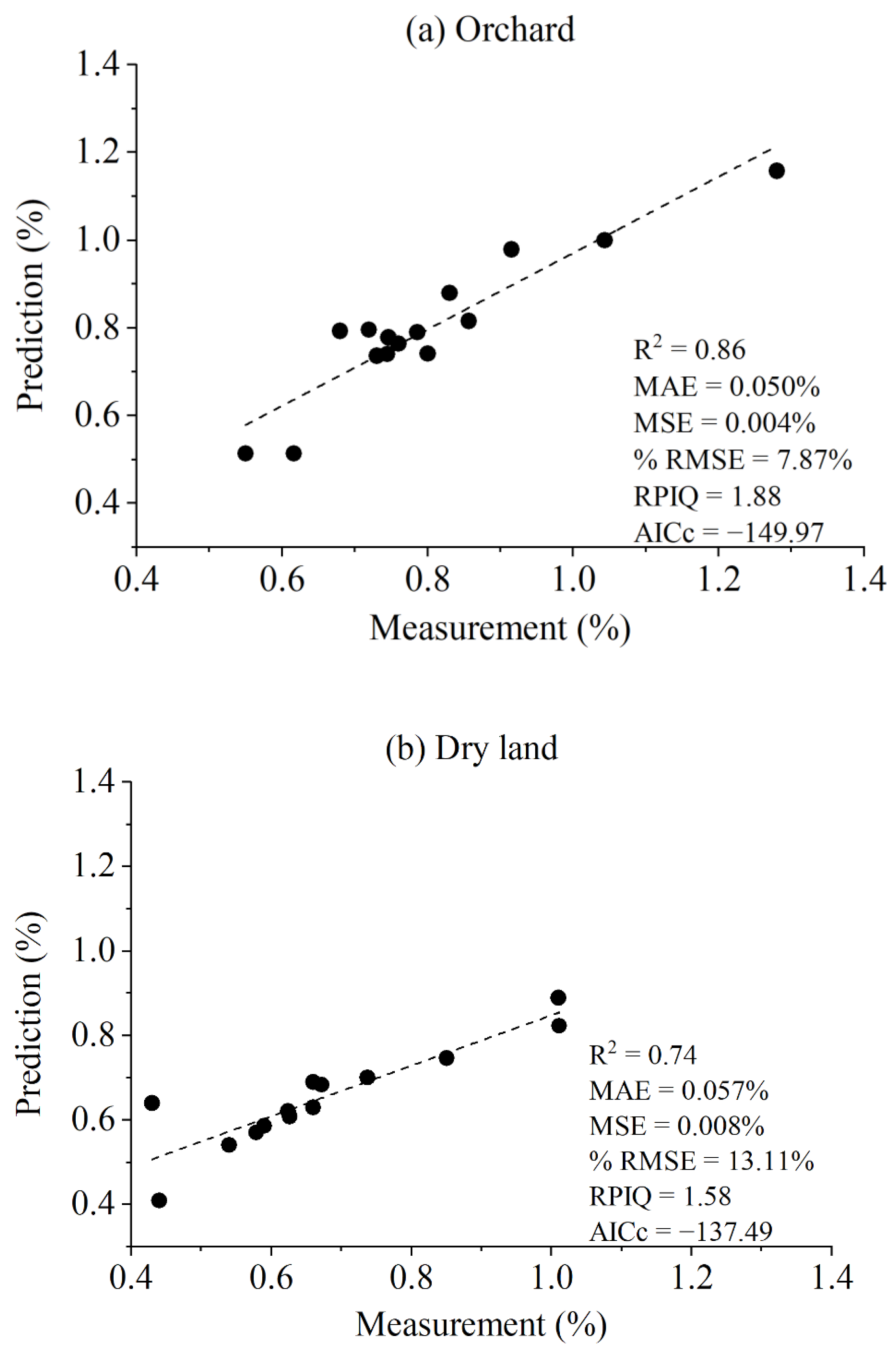
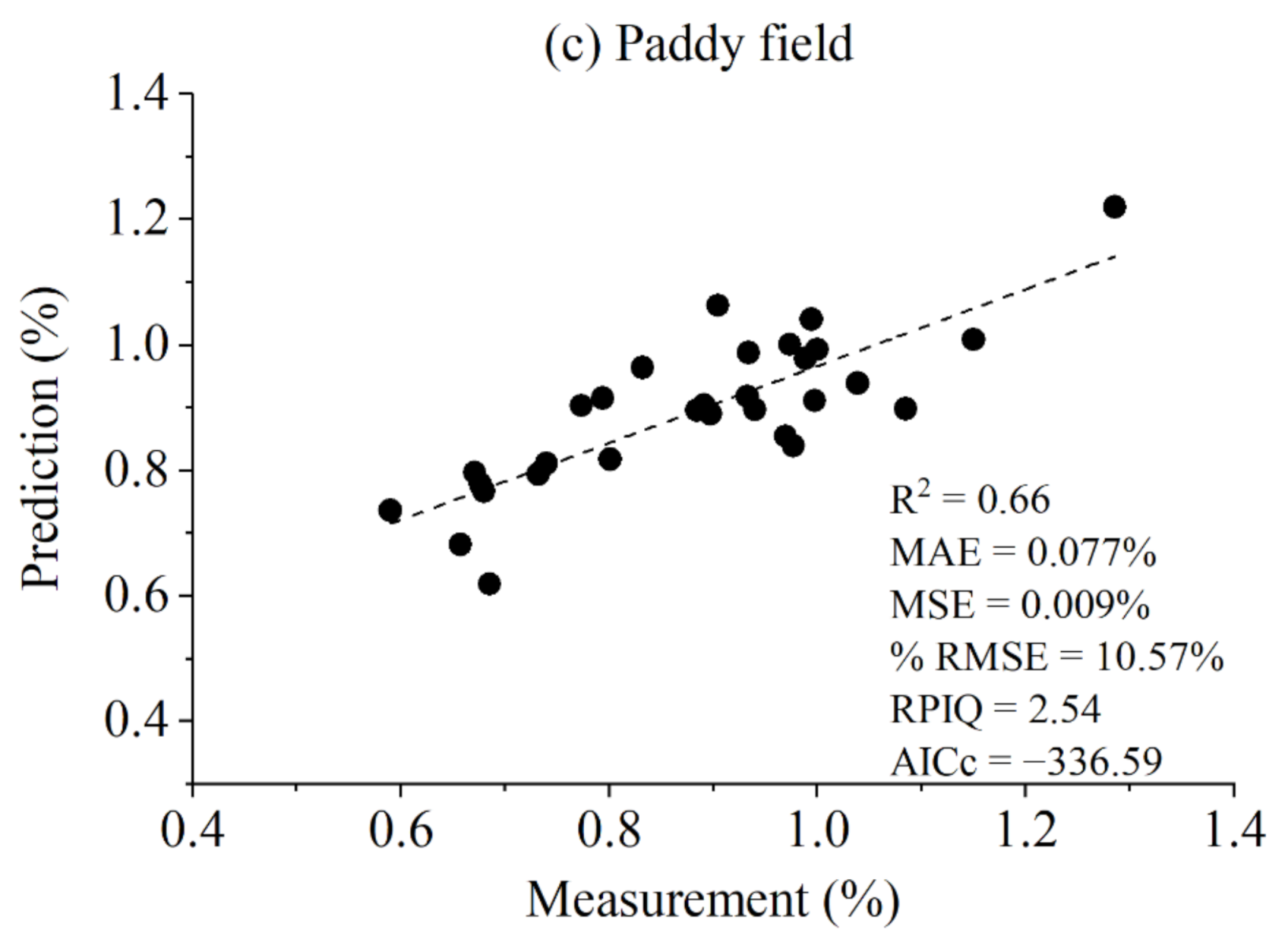

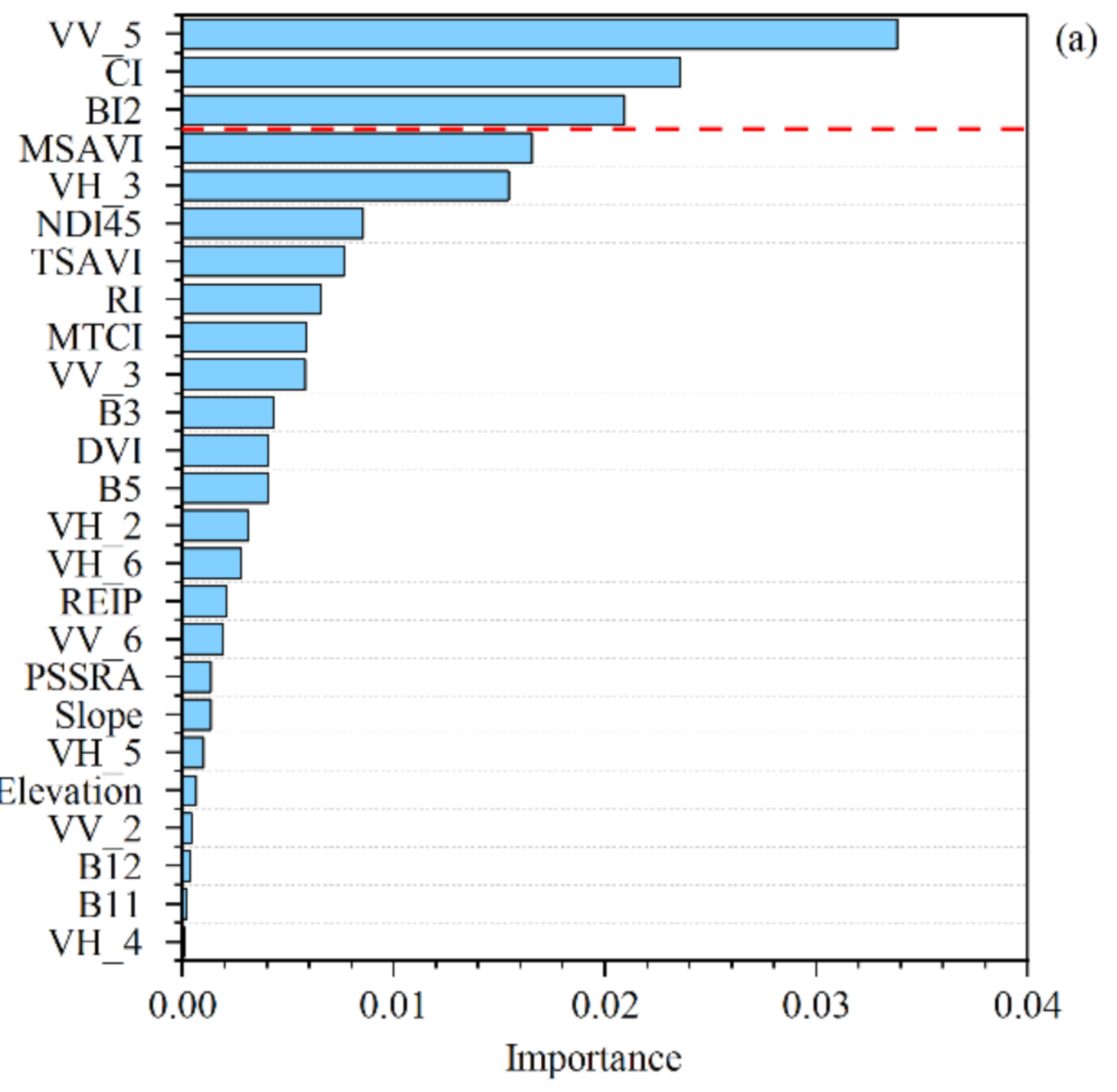
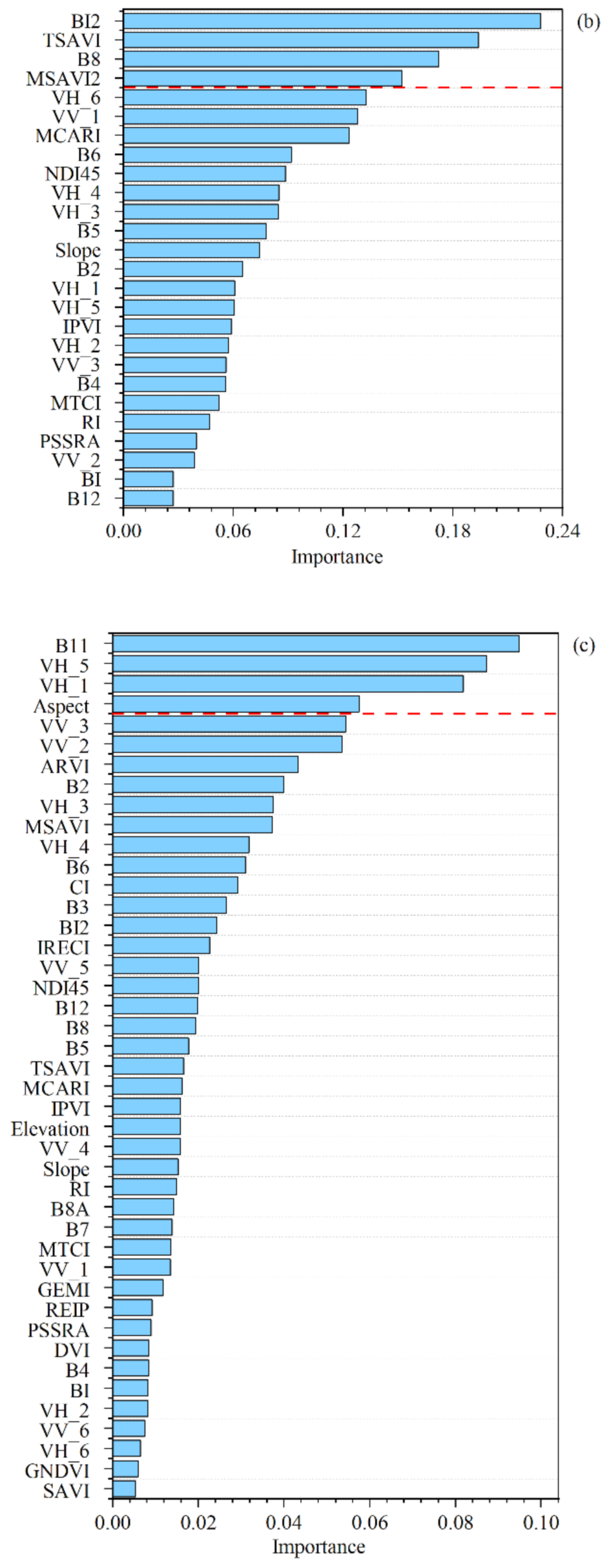
| Polarization | Time | Remark |
|---|---|---|
| VV/VH | 26 October 2018 | VV_1/VH_1 |
| VV/VH | 7 March 2019 | VV_2/VH_2 |
| VV/VH | 6 May 2019 | VV_3/VH_3 |
| VV/VH | 5 July 2019 | VV_4/VH_4 |
| VV/VH | 22 August 2019 | VV_5/VH_5 |
| VV/VH | 15 September 2019 | VV_6/VH_6 |
| Land Use Type | N | Min | Max | Mean | SD | CV | Skewness | Kurtosis |
|---|---|---|---|---|---|---|---|---|
| Total area | 290 | 0.15 | 1.66 | 0.81 | 0.23 | 0.28 | 0.49 | 0.73 |
| Orchard | 75 | 0.40 | 1.32 | 0.76b | 0.19 | 0.25 | 0.95 | 1.10 |
| Dry land | 67 | 0.15 | 1.26 | 0.69b | 0.22 | 0.32 | 0.17 | −0.11 |
| Paddy field | 148 | 0.42 | 1.66 | 0.89a | 0.23 | 0.25 | 0.59 | 0.90 |
| Land Use Type | Model | R2 | MAE (%) | MSE (%) | %RMSE (%) | RPIQ | AICc |
|---|---|---|---|---|---|---|---|
| Total area | Model A | 0.23 | 0.149 | 0.037 | 24.45 | 1.65 | −238.92 |
| Model B | 0.34 | 0.147 | 0.032 | 22.63 | 1.78 | −61.96 | |
| Model C | 0.35 | 0.143 | 0.032 | 22.52 | 1.79 | 548.78 | |
| Orchard | Model A | 0.29 | 0.109 | 0.021 | 17.94 | 0.82 | −308.88 |
| Model B | 0.69 | 0.077 | 0.009 | 11.80 | 1.25 | −132.47 | |
| Model C | 0.85 | 0.053 | 0.005 | 8.35 | 1.77 | −124.74 | |
| Dry land | Model A | 0.49 | 0.090 | 0.015 | 18.24 | 1.14 | −229.70 |
| Model B | 0.50 | 0.092 | 0.015 | 18.18 | 1.14 | −122.61 | |
| Model C | 0.67 | 0.066 | 0.010 | 14.77 | 1.40 | −118.20 | |
| Paddy field | Model A | 0.15 | 0.112 | 0.022 | 16.62 | 1.62 | −99.77 |
| Model B | 0.50 | 0.086 | 0.013 | 12.72 | 2.11 | −402.48 | |
| Model C | 0.66 | 0.077 | 0.009 | 10.57 | 2.54 | −303.45 |
| Model | Land Use Type | R2 | MAE (%) | MSE (%) | %RMSE (%) | RPIQ | AICc |
|---|---|---|---|---|---|---|---|
| Model D | Total area | 0.39 | 0.137 | 0.030 | 21.80 | 1.85 | −14.85 |
| Orchard | 0.86 | 0.050 | 0.004 | 7.87 | 1.88 | −149.97 | |
| Dry land | 0.74 | 0.057 | 0.008 | 13.11 | 1.58 | −137.49 | |
| Paddy field | 0.66 | 0.077 | 0.009 | 10.57 | 2.54 | −336.59 |
Publisher’s Note: MDPI stays neutral with regard to jurisdictional claims in published maps and institutional affiliations. |
© 2021 by the authors. Licensee MDPI, Basel, Switzerland. This article is an open access article distributed under the terms and conditions of the Creative Commons Attribution (CC BY) license (http://creativecommons.org/licenses/by/4.0/).
Share and Cite
Wang, H.; Zhang, X.; Wu, W.; Liu, H. Prediction of Soil Organic Carbon under Different Land Use Types Using Sentinel-1/-2 Data in a Small Watershed. Remote Sens. 2021, 13, 1229. https://doi.org/10.3390/rs13071229
Wang H, Zhang X, Wu W, Liu H. Prediction of Soil Organic Carbon under Different Land Use Types Using Sentinel-1/-2 Data in a Small Watershed. Remote Sensing. 2021; 13(7):1229. https://doi.org/10.3390/rs13071229
Chicago/Turabian StyleWang, Huan, Xin Zhang, Wei Wu, and Hongbin Liu. 2021. "Prediction of Soil Organic Carbon under Different Land Use Types Using Sentinel-1/-2 Data in a Small Watershed" Remote Sensing 13, no. 7: 1229. https://doi.org/10.3390/rs13071229
APA StyleWang, H., Zhang, X., Wu, W., & Liu, H. (2021). Prediction of Soil Organic Carbon under Different Land Use Types Using Sentinel-1/-2 Data in a Small Watershed. Remote Sensing, 13(7), 1229. https://doi.org/10.3390/rs13071229








